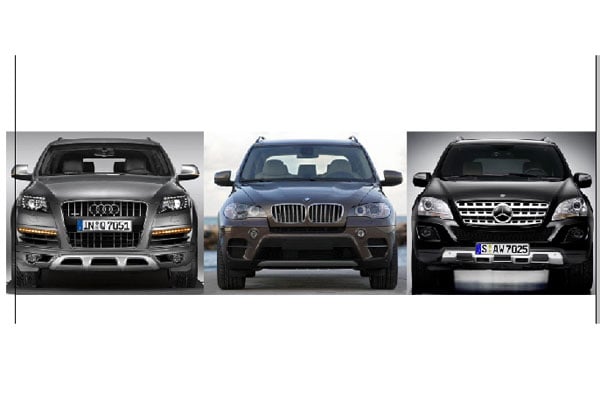The BMW X5 2007 model rates high on safety

What you need to know:
Built with a maximum speed of 320km/hr, the BMW X5 2007 is agreeable to speed lovers yet offers untold comfort and security. It will also, thanks to technology, alert you of how much your fuel reserves contain. Such a beauty to own and drive
Elvis Karuhanga drives a BMW X5 2007 model. A Sport Utility Vehicle (SUV) by classification, his is the American version, built with a wide shape. Unlike the German version that sits five passengers, including the driver, Karuhanga’s can comfortably seat seven passengers because its wide size creates more interior space, especially a wide sitting area for the passengers.
Car specs
Running on a 3000cc petrol engine, in terms of performance, Karuhanga’s X5 runs with Variable Valve Timing intelligence (VVTI) technology. This technology provides for less fuel consumption when the vehicle is in high performance, especially when cruising at high speeds. When it comes to off-road capabilities, the X5 also has the Dynamic Stability Control (DSC) function, a technology that improves the vehicle stability for better off-road performance especially along slippery marrum roads.
“The dynamic stability control system increases the efficiency of the 4X4 system. In the process of applying pressure on the braking or acceleration system, when the car is skidding, the DSC function increases the car stability by technologically determining which side of the tyre is undergoing slippery variations. The function prevents the tyre from slipping a lot,” Karuhanga explains.
Built with a maximum speed of 320km/hr, the ground clearance of the 2007 model X5 is compared to that of the Toyota Land Cruiser and the Mercedes Benz 4Matic, rendering it enough to be driven along any marrum roads.
In terms of fuel consumption, this BMW is one that gives you alerts on the dashboard for every added drop of fuel. On the dashboard, it shows you how much fuel you have left in the tank and how long it can take you. For instance, fuel worth Shs50,000 covers a distance of approximately 69 kilometres.
However, if you are the kind of motorist who loves carrying out modifications on vehicles, the X5 is not one to tamper with.
“When you can carry out modifications on the car, especially those linked to fuel consumption, it affects its performance. For example, the rims come in different sizes. If your car was prescribed to have 19-inch rims and you give it 22 inches, it increases the consumption because the revolutions per minute are not the recommended ones. The same goes for the X5,” says Willy Agaba, a German car mechanic at Ntinda.
Service and maintenance
Service and maintenance depends on usability of the vehicle. On the market, you will find engine oil grades prescribed for use for a maximum of 5,000km for replacement and oil grades which you can drive up to 25,000km. Unfortunately, the harsh African conditions may not guarantee such mileage, but with the BMW X5 2007 model, you will be required to replace engine oil after driving 17,000km from the recommended mileage. It uses seven litres of oil and on average, you will buy good quality oil for the X5 ranging between Shs35,000 to Shs50,000, depending on where you buy it.
Apart from engine oil, Agaba says the commonly replaced parts depend on the engine type. When you drive an X5 with a 3000cc diesel engine, its serviceable and replaceable parts will be different from those of running a 3000cc petrol engine.
“You are advised to change parts such as the air cleaners frequently because it has sensors such as airflow meters that enable you to have better performance and clean combustion. When the cleaners are dirty, the performance will not be smooth. You will also replace the spark plugs and brake pads quite often,” Agaba adds.
Safety features
Much as it is not safe and illegal n Uganda, the X5 is one with capability of allowing you to negotiate a corner at 200km/hr. Other than the dynamic stability control system and the dynamic traction control system, which are common with some BMW X5s, depending on the model you go for, the car is sporty, and the seats hold and keep you in one position in case of a collision, as long as you are wearing a seatbelt. It also runs on an independent suspension system in that if you are affected on one side, you cannot feel the impact on the other.
Technology upgrades
According to Car and Driver, an online portal, the coordination of Electronic Damping Control and Active Roll Stabilisation of the BMW X5 is handled by adaptive drive. This is a system that promises superior dynamic control.
“The system works by processing data from numerous sensors to control body motion and magnetically-controlled damper valving. Press the Sport button on the centre console and a different handling map will shore up the footwork with more aggressive valving and anti-roll bar settings,” the portal says.
Maintenance
Apart from engine oil, the commonly replaced parts depend on the engine type. When you drive an X5 with a 3000cc diesel engine, its serviceable and replaceable parts will be different from those of running a 3000cc petrol engine.
You are also advised to change parts such as the air cleaners frequently because it has sensors such as airflow meters that enable you to have better performance and clean combustion. When the cleaners are dirty, the performance will not be smooth. You will also replace the spark plugs and brake pads quite often




